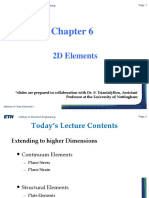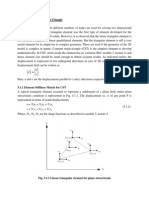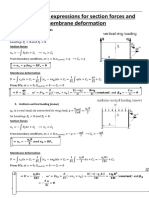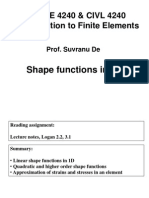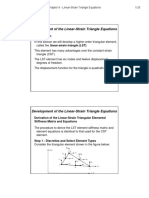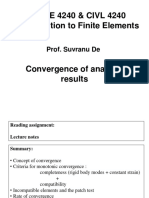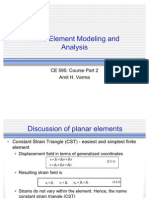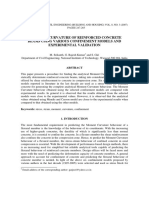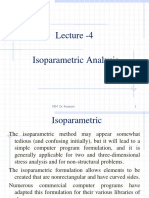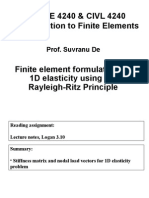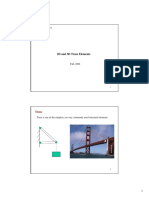Chapter 6. Solid Elements For 3-D Problems I. 3-D Elasticity Theory
Uploaded by
Shanmukha SundaramChapter 6. Solid Elements For 3-D Problems I. 3-D Elasticity Theory
Uploaded by
Shanmukha SundaramLecture Notes: Introduction to Finite Element Method Chapter 6.
Solid Elements
1999 Yijun Liu, University of Cincinnati 138
Chapter 6. Solid Elements for 3-D Problems
I. 3-D Elasticity Theory
Stress State:
y
F
x
z
y
yx
yz
zy
zx
xz
xy
y , v
x, u
z, w
Lecture Notes: Introduction to Finite Element Method Chapter 6. Solid Elements
1999 Yijun Liu, University of Cincinnati 139
{ }
[ ]
) 1 ( ,
ij
zx
yz
xy
z
y
x
or
'
Strains:
{ }
[ ]
) 2 ( ,
ij
zx
yz
xy
z
y
x
or
'
Stress-strain relation:
'
1
1
1
1
1
1
1
1
1
]
1
'
zx
yz
xy
z
y
x
zx
yz
xy
z
y
x
v
v
v
v v v
v v v
v v v
v v
E
2
2 1
0 0 0 0 0
0
2
2 1
0 0 0 0
0 0
2
2 1
0 0 0
0 0 0 1
0 0 0 1
0 0 0 1
) 2 1 )( 1 (
or ) 3 ( E
Lecture Notes: Introduction to Finite Element Method Chapter 6. Solid Elements
1999 Yijun Liu, University of Cincinnati 140
Displacement:
) 4 (
) , , (
) , , (
) , , (
3
2
1
'
'
u
u
u
z y x w
z y x v
z y x u
u
Strain-Displacement Relation:
) 5 ( , ,
, , ,
x
w
z
u
z
v
y
w
y
u
x
v
z
w
y
v
x
u
xz yz xy
z y x
or
( )
( )
notation) tensor (
2
1
simply, or
3 , 2 , 1 , ,
2
1
, , i j j i ij
i
j
j
i
ij
u u
j i
x
u
x
u
+
,
_
Lecture Notes: Introduction to Finite Element Method Chapter 6. Solid Elements
1999 Yijun Liu, University of Cincinnati 141
Equilibrium Equations:
0
or
, 0
) 6 ( , 0
, 0
,
+
+
i j ij
z
z
zy
zx
y
yz y yx
x
xz
xy
x
f
f
z y x
f
z y x
f
z y x
Boundary Conditions (BCs):
) traction (
) 7 ( ) ( ,
) ( ,
j ij i
i i
u i i
n t
traction specified on t t
nt displaceme specified on u u
Stress Analysis:
Solving equations in (6) under the BCs in (7).
p
n
) (
+
u
Lecture Notes: Introduction to Finite Element Method Chapter 6. Solid Elements
1999 Yijun Liu, University of Cincinnati 142
II. Finite Element Formulation
Displacement Field:
i
N
i
i
i
N
i
i
N
i
i i
w N w
v N v
u N u
1
1
1
) 8 (
Nodal values
In matrix form:
) 9 (
) 1 3 (
) 3 3 ( ) 1 3 (
2
2
2
1
1
1
2 1
2 1
2 1
0 0 0 0
0 0 0 0
0 0 0 0
'
1
1
]
1
'
N
N
w
v
u
w
v
u
N N
N N
N N
w
v
u
M
L
L
L
or d N u
Using relations (5) and (8), we can derive the strain vector
=B d
(61) (63N)(3N1)
Lecture Notes: Introduction to Finite Element Method Chapter 6. Solid Elements
1999 Yijun Liu, University of Cincinnati 143
Stiffness Matrix:
) 10 (
v
T
dv B E B k
(3N) (3N6)(66)(63N)
Numerical quadratures are often needed to evaluate the
above integration.
Rigid-body motions for 3-D bodies (6 components):
3 translations, 3 rotations.
These rigid-body motions (singularity of the system of
equations) must be removed from the FEA model to ensure the
quality of the analysis.
You might also like
- 10-Linear Strain Triangle and Other Types of 2d Elements100% (1)10-Linear Strain Triangle and Other Types of 2d Elements31 pages
- Lecture - 6 - CH Quad4 Kirchoff Love PlateNo ratings yetLecture - 6 - CH Quad4 Kirchoff Love Plate53 pages
- Chapter 8 - Linear-Strain Triangle Equations: Learning ObjectivesNo ratings yetChapter 8 - Linear-Strain Triangle Equations: Learning Objectives31 pages
- Other Through Special Points ("Nodes") P P 3 2 1 4 3No ratings yetOther Through Special Points ("Nodes") P P 3 2 1 4 331 pages
- Higher Order Elements: Steps in The Formulation of LST Element Stiffness Equations100% (1)Higher Order Elements: Steps in The Formulation of LST Element Stiffness Equations7 pages
- Derivation of Expressions For Section Forces and Membrane Deformation100% (1)Derivation of Expressions For Section Forces and Membrane Deformation47 pages
- GUI Program For 2D-Truss Analysis: Developed in MATLAB 7.0No ratings yetGUI Program For 2D-Truss Analysis: Developed in MATLAB 7.013 pages
- MANE 4240 & CIVL 4240 Introduction To Finite Elements: Shape Functions in 1DNo ratings yetMANE 4240 & CIVL 4240 Introduction To Finite Elements: Shape Functions in 1D29 pages
- University of Engineering & Technology, Peshawar, PakistanNo ratings yetUniversity of Engineering & Technology, Peshawar, Pakistan64 pages
- Development of The Linear-Strain Triangle EquationsNo ratings yetDevelopment of The Linear-Strain Triangle Equations26 pages
- Ce1403 - Basics of Dynamics and Aseismic Design (For Vii - Semester)No ratings yetCe1403 - Basics of Dynamics and Aseismic Design (For Vii - Semester)6 pages
- Girkmann Problem Using Axisymmetric Shell ElementsNo ratings yetGirkmann Problem Using Axisymmetric Shell Elements9 pages
- C 5 O - F E S F: Hapter NE Dimensional Inite Lement Hape UnctionsNo ratings yetC 5 O - F E S F: Hapter NE Dimensional Inite Lement Hape Unctions48 pages
- MANE 4240 & CIVL 4240 Introduction To Finite Elements: Prof. Suvranu deNo ratings yetMANE 4240 & CIVL 4240 Introduction To Finite Elements: Prof. Suvranu de28 pages
- MATLAB Code For Structural Analysis of 2-D Structures Subjected To Static and Self-Weight Loading ConditionsNo ratings yetMATLAB Code For Structural Analysis of 2-D Structures Subjected To Static and Self-Weight Loading Conditions9 pages
- University of Engineering & Technology, Peshawar, PakistanNo ratings yetUniversity of Engineering & Technology, Peshawar, Pakistan71 pages
- Chap 4 Research Method and Technical WritingNo ratings yetChap 4 Research Method and Technical Writing33 pages
- Reading Assignment: Logan 6.2-6.5 + Lecture Notes SummaryNo ratings yetReading Assignment: Logan 6.2-6.5 + Lecture Notes Summary32 pages
- Universidad Nacional Autónoma de México: FormularioNo ratings yetUniversidad Nacional Autónoma de México: Formulario10 pages
- MANE 4240 & CIVL 4240 Introduction To Finite ElementsNo ratings yetMANE 4240 & CIVL 4240 Introduction To Finite Elements42 pages
- MANE 4240 & CIVL 4240 Introduction To Finite Elements: Prof. Suvranu deNo ratings yetMANE 4240 & CIVL 4240 Introduction To Finite Elements: Prof. Suvranu de40 pages
- Seminariofirenze Ottimizzazione 5 Nov 2012No ratings yetSeminariofirenze Ottimizzazione 5 Nov 2012103 pages
- The Constant Strain Triangle (CST) (Lec 14)No ratings yetThe Constant Strain Triangle (CST) (Lec 14)33 pages
- IV. Nature of Finite Element Solutions: Stiffening EffectNo ratings yetIV. Nature of Finite Element Solutions: Stiffening Effect7 pages
- Introduction To Finite Element Method - Chapt - 02 - Lect04No ratings yetIntroduction To Finite Element Method - Chapt - 02 - Lect049 pages
- Chapter 4. Finite Element Modeling and Solution TechniquesNo ratings yetChapter 4. Finite Element Modeling and Solution Techniques2 pages
- 10-Linear Strain Triangle and Other Types of 2d Elements10-Linear Strain Triangle and Other Types of 2d Elements
- Chapter 8 - Linear-Strain Triangle Equations: Learning ObjectivesChapter 8 - Linear-Strain Triangle Equations: Learning Objectives
- Other Through Special Points ("Nodes") P P 3 2 1 4 3Other Through Special Points ("Nodes") P P 3 2 1 4 3
- Higher Order Elements: Steps in The Formulation of LST Element Stiffness EquationsHigher Order Elements: Steps in The Formulation of LST Element Stiffness Equations
- Derivation of Expressions For Section Forces and Membrane DeformationDerivation of Expressions For Section Forces and Membrane Deformation
- GUI Program For 2D-Truss Analysis: Developed in MATLAB 7.0GUI Program For 2D-Truss Analysis: Developed in MATLAB 7.0
- MANE 4240 & CIVL 4240 Introduction To Finite Elements: Shape Functions in 1DMANE 4240 & CIVL 4240 Introduction To Finite Elements: Shape Functions in 1D
- University of Engineering & Technology, Peshawar, PakistanUniversity of Engineering & Technology, Peshawar, Pakistan
- Development of The Linear-Strain Triangle EquationsDevelopment of The Linear-Strain Triangle Equations
- Ce1403 - Basics of Dynamics and Aseismic Design (For Vii - Semester)Ce1403 - Basics of Dynamics and Aseismic Design (For Vii - Semester)
- Girkmann Problem Using Axisymmetric Shell ElementsGirkmann Problem Using Axisymmetric Shell Elements
- C 5 O - F E S F: Hapter NE Dimensional Inite Lement Hape UnctionsC 5 O - F E S F: Hapter NE Dimensional Inite Lement Hape Unctions
- MANE 4240 & CIVL 4240 Introduction To Finite Elements: Prof. Suvranu deMANE 4240 & CIVL 4240 Introduction To Finite Elements: Prof. Suvranu de
- MATLAB Code For Structural Analysis of 2-D Structures Subjected To Static and Self-Weight Loading ConditionsMATLAB Code For Structural Analysis of 2-D Structures Subjected To Static and Self-Weight Loading Conditions
- University of Engineering & Technology, Peshawar, PakistanUniversity of Engineering & Technology, Peshawar, Pakistan
- Reading Assignment: Logan 6.2-6.5 + Lecture Notes SummaryReading Assignment: Logan 6.2-6.5 + Lecture Notes Summary
- Universidad Nacional Autónoma de México: FormularioUniversidad Nacional Autónoma de México: Formulario
- MANE 4240 & CIVL 4240 Introduction To Finite ElementsMANE 4240 & CIVL 4240 Introduction To Finite Elements
- MANE 4240 & CIVL 4240 Introduction To Finite Elements: Prof. Suvranu deMANE 4240 & CIVL 4240 Introduction To Finite Elements: Prof. Suvranu de
- IV. Nature of Finite Element Solutions: Stiffening EffectIV. Nature of Finite Element Solutions: Stiffening Effect
- Introduction To Finite Element Method - Chapt - 02 - Lect04Introduction To Finite Element Method - Chapt - 02 - Lect04
- Chapter 4. Finite Element Modeling and Solution TechniquesChapter 4. Finite Element Modeling and Solution Techniques


